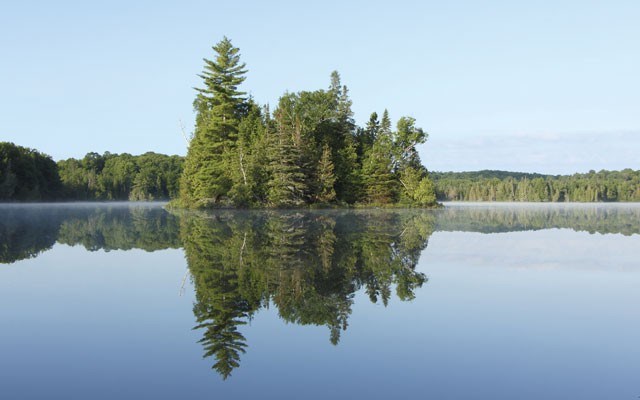Chasing the memory of lumber-driving shantymen on mountain bikes in Ontario's Haliburton Highlands, a friend and I have been served plenty from the area's history department in our first two days. We start our third with a warm-up ride on a rail-line conversion trail that runs 20 kilometres from the towns of Haliburton to Kinmount following a log-drive route along the Drag River to the edge of the Canadian Shield. It's not all as flat as we'd imagined, but pretty enough — even through clouds of hell-bent mosquitoes.
After lunch it's only a three-quarters of an hour's drive to the mother lode of area trails — 300 kilometres worth — in Haliburton Forest and Wild Life Reserve (WLR), though by then the weather is pushing back. Thunderheads boil up to the stratosphere from just above the trees, their leaden bellies casting mid-day eclipses onto already gloomy forest. Every so often a sagging cloud erupts in a fury of teeming rain and wind that briefly drives off the mosquitoes. Though not so much the larger biting insects; as I ride, the contrail of deer flies coalescing in the slipstream of my helmet resembles a scarf composed of electrons, one that blows forward with silken élan to envelope me whenever I slow for a climb. Reasonably fast downhills momentarily tear the unwelcome fabric apart, only to have it reform on level ground.
Mountain biking started in the HF&WLR almost 30 years ago, but was popular enough after only a decade to support a full-time summer trail-cutting and maintenance crew. The network continued to grow along with its popularity for races and rallies. Though the 80,000 acres close for a three-week hunting season in late fall, one of the coolest aspects of riding here is the high likelihood of observing moose, deer, bobcat, otter, beaver, black bear and wolves. In fact there's a wolf pack under continuous scientific observation and HF&WLR offers wolf education to deer and moose hunters so they won't blow the cute little canids away.
My first time riding here had been solo on the extremely difficult Normac Trail. It was hot, muggy, and bug-infested; it was also very wet. At the end of the Normac, where it joins with the Red Trail rounding the eastern end of sandy-bottomed McDonald Lake, I'd ridden right into the water like a deer-driven-mad, easing the pain of myriad bites and washing off the encrusted swamp goo I'd taken on after executing a perfect header from a wooden catwalk into a black mud bog.
This time my buddy and I start on Lookout Trail, which heads across overgrown logging roads before diving into alternately muddy, rocky, and rooty singletrack that turns and twists faster than a computer game. Then it gets technical. A 100-metre vertical rise requires a straight uphill climb over about 400 metres, but at the top we find two great lookouts; one over a lake and river, and the other off a monstrous cliff and out over a steep hillside studded with spruce and birch. It's breezy up here, and there are no bugs, so we linger until the weather closes in again. A long, technical downhill that alternates over bare rock and washed-out clay rivulets returns us to lake level where, in a torrential downpour, we hit the Black Creek Loop, a muddy ribbon rollicking alongside a huge swamp that features live, hopping-toad obstacles.
Several cars with bike racks lurk in the parking area, but we haven't seen another rider all day, and depart Haliburton Forest a pair of very satisfied customers.
Algonquin Park, bordering the Highlands, is Canada's oldest and largest provincial park. A canoeist's paradise of interlocking lakes, rivers and ponds, like HF&WLR it has an extensive logging history and is also a great place to see wildlife. In four short hours in the park we cross paths with two moose and a wolf. At present, there are three dedicated mountain biking areas: the Byers Lake mountain bike trail in the south end of the park, and the Old Railway and Minnesing mountain bike trails along Hwy 60 not far from the park's western gate. At Minnesing, a series of sequential one-way loops gives you 3.5, 5, 11, 17, 23 or 26 km options. The out-tracks are virtually all singletrack through typical Algonquin terrain. On the 17 kilometre loop we ride pine-studded, glacial-lake sandlands, classic tire-sucking boreal bog, quarry-like Shield rock gardens, finely groomed tree-root washboard, sugar maples where light streams through an immature, open canopy onto the verdant green of waist-high undergrowth, and deceptively long climbs that eventually take us a hundred metres above our starting point. The crossover loops and return track are remnants of logging operations and a road to the old Minnesing Lodge abandoned in the 1950s. To our delight, these are generally grown-over doubletrack with nary a hazard in sight, providing for wicked long screaming downhills interrupted by only a few short payback climbs.
After the ride, caked in mud, bugs and sweat, we sip cool Guinnesses we'd stashed in the van, and feel we've communed well with the spirits of the pancake-fed shantymen and log-skidders we were chasing, surmounting the same underfoot and airborne obstacles they would have faced in opening up this land for those, like ourselves, who would eventually come. Of course, the authenticity of any pioneer experience ends there, reminding us that no matter how rough we think we have it, and no matter what the challenges we decide to take on, we're still a pampered pantywaist generation. Furthermore, not only are mountain-bikers sport-minded hedonists whose idea of an honest day's labour is... well... riding bikes in cool places and writing stories about it, but the shantymen's beer — if they'd had any at all — would probably have been warm.
Go to www.piquenewsmagazine.com for Part 1 of this series.
Leslie Anthony is a Whistler-based author, editor, biologist and bon vivant who has never met a mountain he didn't like.




